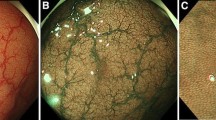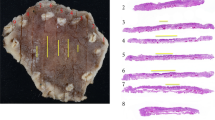Abstract
Background
Magnifying endoscopy with narrow-band imaging (NBI) is effective for the diagnosis of early gastric cancer (EGC). However, magnifying endoscopy is not yet popular globally because of the required level of skill and lack of availability. To overcome these problems, dual-focus endoscopy (standard- and near-focus (NF) modes) has been developed. In this study, we evaluated the diagnostic performance of NF with second-generation (2G)-NBI (NF-NBI) for the diagnosis of EGC.
Methods
This was a secondary analysis of a multicenter randomized controlled trial of 4523 high-risk patients who underwent gastroscopies at 13 institutions in Japan. Patients were randomly assigned to white-light imaging (WLI) followed by 2G-NBI or to 2G-NBI followed by WLI. Lesions suspicious for EGC, newly detected by non-magnifying WLI or 2G-NBI, were subsequently observed with NF-NBI. All detected lesions were biopsied or resected. The diagnostic performance of NF-NBI was compared with the final histology.
Results
A total of 870 detected lesions (145 EGC, 725 non-EGC) were analyzed. Overall diagnostic performance for EGC using NF-NBI was accuracy 87.7%, sensitivity 60.7%, specificity 93.1%, positive predictive value 63.8%, and negative predictive value 92.2%. There were no significant differences in diagnostic performance between lesions detected by WLI or 2G-NBI. For lesions diagnosed with high (333 lesions) and low (537 lesions) confidences, accuracy was 92.2% and 84.9%, sensitivity was 64.7% and 58.5%, and specificity was 90.5% and 88.8%, respectively.
Conclusion
The diagnostic performance of NF-NBI is good and acceptable for diagnosis of EGC in combination with either WLI or 2G-NBI.


Similar content being viewed by others
Abbreviations
- EGC:
-
Early gastric cancer
- NBI:
-
Narrow-band imaging
- M-NBI:
-
Magnifying endoscopy with narrow-band imaging
- 2G-NBI:
-
Second-generation narrow-band imaging
- NF:
-
Near-focus mode
- NF-NBI:
-
Near-focus mode with second-generation narrow-band imaging
- WLI:
-
White-light imaging
- VS classification system:
-
Vessel plus surface classification system
References
Bray F, Ferlay J, Soerjomataram I, et al. Global Cancer Statistics 2018: GLOBOCAN estimates of incidence and mortality worldwide for 36 cancers in 185 countries. CA Cancer J Clin. 2018;68:394–424.
Zhang X, Li M, Chen S, et al. Endoscopic screening in Asian countries is associated with reduced gastric cancer mortality: a meta-analysis and systematic review. Gastroenterology. 2018;155:347–54.
Banks M, Graham D, Jansen M, et al. British society of gastroenterology guidelines on the diagnosis and management of patients at risk of gastric adenocarcinoma. Gut. 2019;68:1545–75.
Pimentel-Nunes P, Libanio D, Marcos-Pinto R, et al. Management of epithelial precancerous conditions and lesions in the stomach (MAPS II): European society of gastrointestinal endoscopy (ESGE), European helicobacter and microbiota study group (EHMSG), European society of pathology (ESD), and Sociedade portuguesa de endoscopia digestiva (SPE) guideline update 2019. Endoscopy. 2019;51:365–8.
Nakayoshi T, Tajiri H, Matsuda K, et al. Magnifying endoscopy combined with narrow band imaging system for early gastric cancer: correlation of vascular pattern with histopathology (including video). Endoscopy. 2004;36:1080–4.
Yao K, Anagnostopoulos GK, Ragunath K. Magnifying endoscopy for diagnosing and delineating early gastric cancer. Endoscopy. 2009;41:462–7.
Kato M, Kaise M, Yonezawa J, et al. Magnifying endoscopy with narrow-band imaging achieves superior accuracy in the differential diagnosis of superficial gastric lesions identified with white-light endoscopy: a prospective study. Gastrointest Endosc. 2010;72:523–9.
Ezoe Y, Muto M, Uedo N, et al. Magnifying narrowband imaging is more accurate than conventional white-light imaging in diagnosis of gastric mucosal cancer. Gastroenterology. 2011;141:2017–25.
Li H, Dai J, Xue H, et al. Application of magnifying endoscopy with narrow-band imaging in diagnosing gastric lesions: a prospective study. Gastrointest Endosc. 2012;76:1124–32.
Yao K, Doyama H, Gotoda T, et al. Diagnostic performance and limitation of magnifying narrow-band imaging in screening endoscopy of early gastric cancer: a prospective multicenter feasibility study. Gastric Cancer. 2014;17:669–79.
Zhang Q, Wang F, Chen Z-Y, et al. Comparison of the diagnostic efficacy of white light endoscopy and magnifying endoscopy with narrow-band imaging for early gastric cancer: a meta-analysis. Gastric Cancer. 2016;19:543–52.
Goda K, Dobashi A, Tajiri H. Perspectives on narrow-band imaging endoscopy for superficial squamous neoplasms of the orohypopharynx and esophagus. Dig Endosc. 2014;26(Suppl 1):1–11.
Goda K, Dobashi A, Yoshimura N, et al. Dual-focus versus conventional magnification endoscopy for the diagnosis of superficial squamous neoplasm in the pharynx and esophagus: a randomized trial. Endoscopy. 2016;48:321–9.
Ikematsu H, Matsuda T, Osera S, et al. Usefulness of narrow-band imaging with dual-focus magnification for differential diagnosis of small colorectal polyp. Surg Endosc. 2015;29:844–50.
Singh R, Jayanna M, Navadgi S, et al. Narrow-band imaging with dual focus magnification in differentiating colorectal neoplasia. Dig Endosc. 2013;25:16–20.
Kim JW, Jung Y, Jang JY, et al. Narrowband imaging with near-focus magnification for discriminating the gastric tumor margin before endoscopic resection; a prospective randomized multicenter trial. J Gastroenterol Hepatol. 2020. https://doi.org/10.1111/jgh.15109.
Yoshida N, Doyama H, Yano T, et al. Early gastric cancer detection in high risk patients: a multicenter randomized controlled trial on the effect of second-generation narrow band imaging. Gut. 2020. https://doi.org/10.1136/gutjnl-2019-319631.
Nunobe S, Oda I, Ishikawa T, et al. Surgical outcomes of elderly patients with Stage I gastric cancer from the nationwide registry of the Japanese Gastric Cancer Association. Gastric Cancer. 2020;23:328–38.
Shibuya H, Wakita T, Nakagawa T, et al. The relation between an esophageal cancer and associated cancers in adjacent organs. Cancer. 1995;76:101–5.
Natsugoe S, Matsumoto M, Okumura H, et al. Multiple primary carcinomas with esophageal squamous cell cancer: clinicopathologic outcome. World J Surg. 2005;29:46–9.
Shimizu H, Okada M, Tangoku A, et al. Thoracic and cardiovascular surgeries in Japan during 2017. Gen Thorac Cardiovasc Surg. 2020;68:414–49.
Muto M, Yao K, Kaise M, et al. Magnifying endoscopy simple diagnostic algorithm for early gastric cancer (MESDA-G). Digestive Endosc. 2016;28:379–93.
Dixon MF. Gastrointestinal epithelial neoplasia: vienna revisited. Gut. 2002;51:130–1.
Tao G, Xing-hua L, Ai-ming Y, et al. Enhanced magnifying endoscopy for differential diagnosis of superficial gastric lesions identified with white-light endoscopy. Gastric Cancer. 2014;17:122–9.
Dohi O, Yagi N, Majima A, et al. Diagnostic ability of magnifying endoscopy with blue lase imaging for early gastric cancer: a prospective study. Gastric Cancer. 2017;20:297–303.
Maki S, Yao K, Nagahama T, et al. Magnifying endoscopy with narrow-band imaging is useful in the differential diagnosis between low-grade adenoma and early cancer of superficial elevated gastric lesions. Gastric Cancer. 2013;16:140–6.
Watabe H, Mitsushima T, Yamaji Y, et al. Predicting the development of gastric cancer from combining Helicobacter pylori antibodies and serum pepsinogen status: a prospective endoscopic cohort study. Gut. 2005;54:764–8.
Fukase K, Kato M, Kikuchi S, et al. Japan Gast Study Group: effect of eradication of Helicobacter pylori on incidence of metachronous gastric carcinoma after endoscopic resection of early gastric cancer: an open-label, randomized controlled trial. Lancet. 2008;372:392–7.
Choi IJ, Kook MC, Kim YI, et al. Helicobacter pylori therapy for the prevention of metachronous gastric cancer. N Engl J Med. 2018;378:1085–95.
Take S, Mizuno M, Ishiki K, et al. The long-term risk of gastric cancer after the successful eradication of Helicobacter pylori. J Gastroenterol. 2011;46:318–24.
Abe S, Oda I, Suzuki H, et al. Long-term surveillance and treatment outcomes of metachronous gastric cancer occurring after curative endoscopic submucosal dissection. Endoscopy. 2015;47:1113–8.
Nagahama T, Yao K, Maki S, et al. Usefulness of magnifying endoscopy with narrow-band imaging for determining the horizontal extent of early gastric cancer when there is an unclear margin by chromoendoscopy. Gastrointest Endosc. 2011;74:1259–67.
Okada K, Fujisaki J, Kasuga A, et al. Diagnosis of undifferentiated type early gastric cancers by magnification endoscopy with narrow-band imaging. J Gastroenterol Hepatol. 2011;26:1262–9.
Kobayashi M, Hashimoto S, Nishikura K, et al. Magnifying narrow-band imaging of surface maturation in early differentiated-type gastric cancers after Helicobacter pylori eradication. J Gastroenterol. 2013;48:1332–42.
Kitamura Y, Ito M, Matsu T, et al. Characteristic epithelium with low-grade atypia appears on the surface of gastric cancer after successful Helicobacter pylori eradication therapy. Helicobacter. 2014;19:289–95.
Masuda K, Urabe Y, Ito M, et al. Genomic landscape of epithelium with low-grade atypia on gastric cancer after Helicobacter pylori eradication therapy. J Gastroenterol. 2019;54:907–15.
Hata K, Ito M, Boda T, et al. Gastric cancer with submucosal invasion after successful Helicobacer pylori eradication: a propensity score-matched analysis of patients with annual patient endoscopic survey. Digestion. 2019;99:59–655.
Acknowledgements
We thank all the investigators who conducted the study at 13 participating institutions, and Eri Okuda who supported data management at Medical Research Support (Osaka, Japan).
Funding
This study was funded by joint research funds supplied by Kyoto University and the Olympus Corporation. Conflicts of interest exist between Kyoto University and Olympus Corporation, but not between other participating institutions. The funding source had no role in the conduct of the study; the collection, management, analysis, or interpretation of the data; or in the preparation, review, or approval of the article.
Author information
Authors and Affiliations
Corresponding author
Ethics declarations
Conflict of interest
Manabu Muto received grants from Olympus during the study period. Tomonori Yano received personal fees and non-financial support from Olympus, outside the submitted work. Other authors have nothing to declare.
Human rights statement and informed consent
All procedures followed were in accordance with the ethical standards of the responsible committee on human experimentation (institutional and national) and with the Helsinki Declaration of 1964 and later versions. Informed consent to be included in the study was obtained from all patients.
Additional information
Publisher's Note
Springer Nature remains neutral with regard to jurisdictional claims in published maps and institutional affiliations.
Electronic supplementary material
Below is the link to the electronic supplementary material.
535_2020_1734_MOESM1_ESM.pptx
Supplementary file1 Electronic supplementary material 1. Examples of first-generation NBI(A) and 2G-NBI(B) without magnification. (PPTX 1198 kb)
535_2020_1734_MOESM2_ESM.pptx
Supplementary file2 Electronic supplementary material 2. A: A slightly elevated lesion was detected by 2G-NBI standard-focus (green square). The lesion was further observed by near-focus mode (B). (PPTX 486 kb)
535_2020_1734_MOESM3_ESM.pptx
Supplementary file3 Electronic supplementary material 3. A representative figure of EGC observed with NF-NBI. A clear demarcation line can be recognized between the non-tumorous mucosa and depressed area (yellow arrows), with an irregular microsurface pattern within the depressed area, according to the VS classification system. (PPTX 284 kb)
535_2020_1734_MOESM4_ESM.docx
Supplementary file4 Electronic supplementary material 4. Characteristics of detected EGC between differentiated and undifferentiated type. (DOCX 13 kb)
535_2020_1734_MOESM5_ESM.docx
Supplementary file5 Electronic supplementary material 5. Comparison of diagnostic performance of NF-NBI with previous studies of M-NBI. (DOCX 14 kb)
Supplementary file6 Electronic supplementary movie. White-light, 2G-NBI and NF-NBI observation of a depressed type EGC. (MP4 9874 kb)
Rights and permissions
About this article
Cite this article
Kakushima, N., Yoshida, N., Doyama, H. et al. Near-focus magnification and second-generation narrow-band imaging for early gastric cancer in a randomized trial. J Gastroenterol 55, 1127–1137 (2020). https://doi.org/10.1007/s00535-020-01734-3
Received:
Accepted:
Published:
Issue Date:
DOI: https://doi.org/10.1007/s00535-020-01734-3




